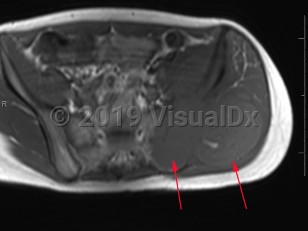Ewing sarcoma in Adult
Alerts and Notices
Important News & Links
Synopsis
Ewing sarcoma is a small, round, blue cell tumor that primarily affects bone and soft tissue. It is often metastatic and has been found in a variety of organs. It typically presents with bone or soft tissue pain. Ewing sarcoma most commonly affects adolescent males. It is considered a poorly-differentiated malignancy on the primitive neuroectodermal tumor (PNET) spectrum. Ewing sarcoma is categorized as a "small round blue cell tumor" due to its histologic appearance, which it shares with other types of malignancies. Ewing sarcomas may be differentiated from these other tumors by CD99 positivity, presence of rosettes on microscopy, and a t(11;22) translocation, which nearly all Ewing sarcomas contain.
Treatment consists of systemic chemotherapy and surgical excision of the primary tumor. Radiotherapy is also sometimes utilized. Prognosis depends on multiple factors, but Ewing sarcoma can be curable even when metastatic.
Treatment consists of systemic chemotherapy and surgical excision of the primary tumor. Radiotherapy is also sometimes utilized. Prognosis depends on multiple factors, but Ewing sarcoma can be curable even when metastatic.
Codes
ICD10CM:
C41.9 – Malignant neoplasm of bone and articular cartilage, unspecified
SNOMEDCT:
76909002 – Ewing's sarcoma
C41.9 – Malignant neoplasm of bone and articular cartilage, unspecified
SNOMEDCT:
76909002 – Ewing's sarcoma
Differential Diagnosis & Pitfalls

To perform a comparison, select diagnoses from the classic differential
Subscription Required
Best Tests
Subscription Required
References
Subscription Required
Last Updated:12/22/2015
Ewing sarcoma in Adult

